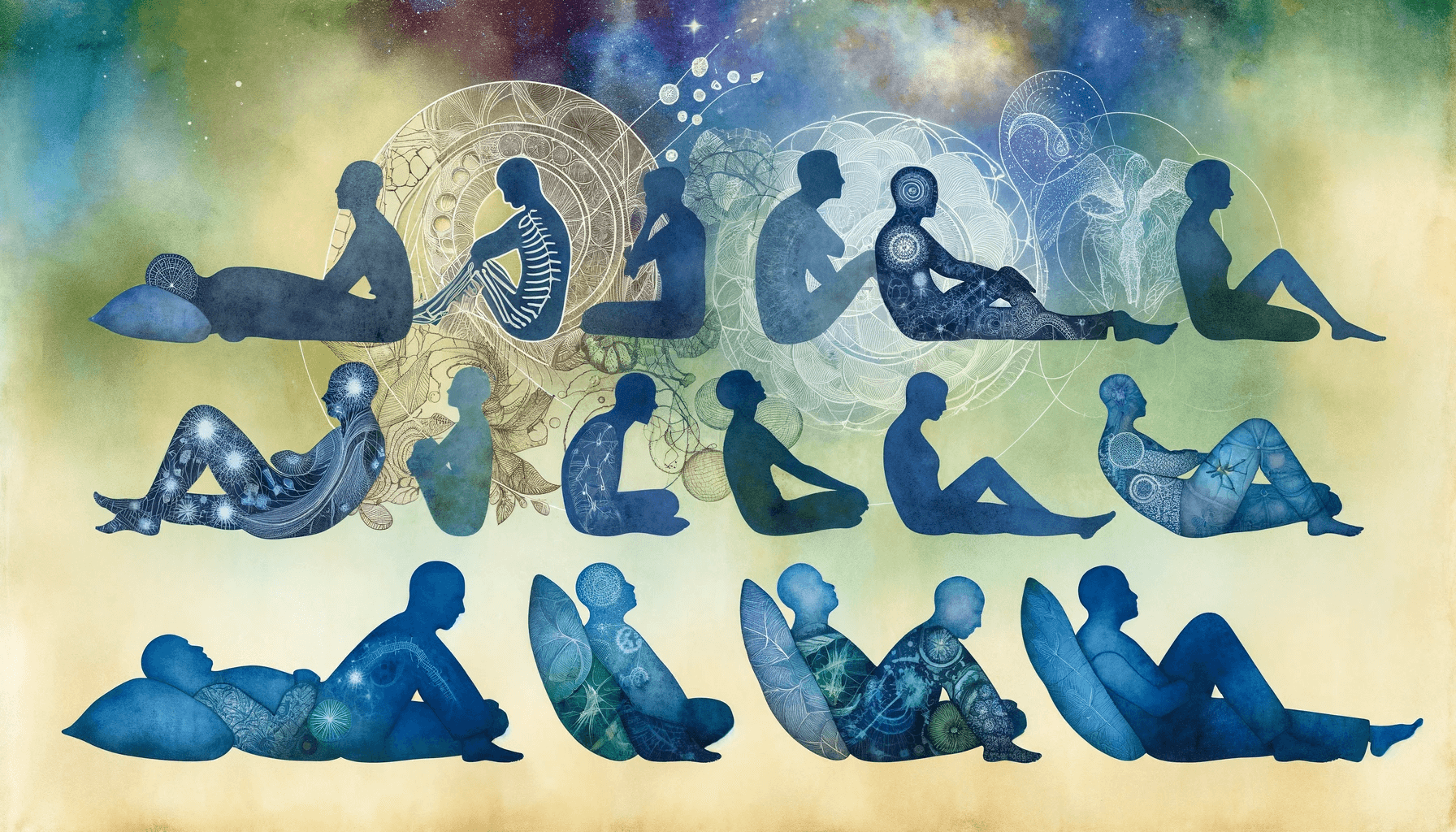Sponsor LeanBiome
Table of Contents
Introduction to sleep positions and their impact on health
As we spend approximately one-third of our lives sleeping, it is crucial to understand the impact of our sleep positions on our overall health and well-being. A good night’s sleep is not only determined by the duration but also by the quality of sleep. The position in which we sleep plays a significant role in this regard. This article will explore the various sleep positions, their pros and cons, and how they can affect our health.
The most common sleep positions and their pros and cons
There are three main sleep positions that most people adopt: back sleeping, side sleeping, and stomach sleeping. Each position has its advantages and disadvantages.
Back sleeping, also known as prone sleeping, is widely considered the best position for spinal alignment. It helps distribute the body weight evenly, reducing the risk of developing pressure points. However, back sleeping can worsen snoring and sleep apnea symptoms, as gravity tends to pull the tongue and soft tissues towards the back of the throat, obstructing the airway.
Side sleeping, particularly on the left side, is beneficial for digestion and reducing acid reflux symptoms. It also improves circulation and reduces the likelihood of snoring. However, side sleeping can lead to shoulder and hip pain if proper support is not provided. It can also cause wrinkles due to the pressure exerted on the face during sleep.
Stomach or prone sleeping can help alleviate snoring and sleep apnea symptoms. However, it can strain the neck and spine, leading to pain and discomfort. It also puts pressure on the organs, potentially causing digestive issues.
How sleep positions affect your spine and posture
The position in which we sleep can significantly impact our spine and posture alignment. Back sleeping is generally considered the best position for spinal alignment, as it allows the spine to maintain its natural curvature. It evenly distributes the body weight, reducing the strain on the spine and minimizing the risk of developing back pain.
Side sleeping can also benefit spinal alignment with the proper pillow and mattress support. Placing a pillow between the knees helps align the hips, pelvis, and spine. On the other hand, stomach sleeping can lead to an unnatural curvature of the spine, straining the neck and causing pain and discomfort.
To ensure proper spinal alignment and posture during sleep, it is essential to choose a mattress and pillow that provide adequate support. Investing in a quality sleep surface can greatly improve your overall sleep experience and reduce the risk of developing musculoskeletal issues.
The connection between sleep positions and sleep quality
The position in which we sleep can significantly impact the quality of our sleep. Back sleeping is often associated with better sleep quality, as it helps maintain an open airway, reducing the risk of snoring and sleep apnea. It also minimizes the chance of developing sleep wrinkles and promotes better blood circulation.
Side sleeping is also considered conducive to good sleep quality, especially for individuals who suffer from snoring or sleep apnea. The airway remains open by sleeping on the side, allowing unrestricted breathing. This position also promotes healthy blood flow and reduces the likelihood of waking up with aches and pains.
Stomach sleeping, however, can negatively affect sleep quality. It is more likely to cause discomfort and strain on the neck and spine, leading to interrupted sleep. Additionally, stomach sleeping can increase the risk of snoring and sleep apnea symptoms due to the pressure exerted on the airway.
To optimize sleep quality, finding a position that promotes comfort, good breathing, and optimal spinal alignment is essential. Experimenting with different sleep positions and investing in the right sleep accessories can greatly enhance the quality of your sleep.
Sleep positions and their impact on snoring and sleep apnea
Snoring and sleep apnea can significantly impact the quality of sleep and overall health and well-being. The position in which we sleep can either exacerbate or alleviate these conditions.
Back sleeping is known to worsen snoring and sleep apnea symptoms. The force of gravity pulls the tongue and soft tissues towards the back of the throat, obstructing the airway and leading to snoring and disrupted breathing. Individuals with snoring or sleep apnea should avoid sleeping on their back and opt for side sleeping.
Side sleeping, particularly on the left side, is considered the best sleep position for individuals with snoring or sleep apnea. It helps keep the airway open and reduces the chances of obstruction. Elevating the upper body with a pillow can alleviate snoring and sleep apnea symptoms.
Stomach sleeping can also help alleviate snoring and sleep apnea symptoms, as it keeps the airway open. However, it is important to note that stomach sleeping can strain the neck and spine, leading to other musculoskeletal issues. Individuals with snoring or sleep apnea who choose to sleep on their stomach should ensure proper support for the neck and spine.
Sleep positions and their impact on digestion and acid reflux
Sleep positions can also influence digestion and the occurrence of acid reflux. Certain sleep positions can either alleviate or exacerbate these conditions.
Back sleeping is generally considered the worst position for individuals with acid reflux. When lying flat on the back, stomach acid can easily flow back into the esophagus, leading to heartburn and discomfort. Elevating the upper body with a pillow can help reduce acid reflux symptoms and improve digestion.
Side sleeping, particularly on the left side, is highly recommended for individuals with acid reflux. This position helps keep the stomach below the esophagus, preventing the backflow of stomach acid. It also aids in digestion and reduces the likelihood of heartburn.
Stomach sleeping, however, can worsen acid reflux symptoms. The pressure exerted on the stomach can force acid into the esophagus, causing heartburn and discomfort. Individuals with acid reflux should avoid sleeping on their stomachs and opt for back or side sleeping instead.
The best sleep positions for specific health conditions
Sleep positions can also play a crucial role in managing specific health conditions. For example, pregnant women often find getting comfortable and maintaining a proper sleep position challenging. Sleeping on the left side is generally recommended during pregnancy, as it improves blood circulation to the fetus and reduces the risk of complications.
Individuals with chronic back pain can benefit from back sleeping with proper support. Placing a pillow under the knees helps maintain the spine’s natural curvature and alleviates pressure on the lower back. Side sleeping with a pillow between the knees can also help reduce back pain.
Those suffering from sleep disorders, such as sleep apnea or snoring, should avoid back sleeping and opt for side or stomach sleeping positions. Elevating the upper body with a pillow can further alleviate symptoms.
How to find the right sleep position for you
Finding the right sleep position for optimal health and well-being is a personal journey. It may require trial and error to determine the best position for you. Here are some tips to help you find the right sleep position:
- Consider your specific health conditions and consult with a healthcare professional if needed.
- Experiment with different sleep positions and pay attention to how your body feels in each position.
- Invest in high-quality mattresses and pillows that adequately support your chosen sleep position.
- Use additional support accessories, such as body pillows or wedge pillows, to enhance comfort and alignment.
- Be patient and give yourself time to adjust to a new sleep position. Finding the optimal position for your body may take a few nights or weeks.
Tips for improving your sleep position
Regardless of the sleep position you choose, some general tips can help improve your overall sleep experience:
- Create a comfortable sleep environment by ensuring your mattress, pillows, and bedding are clean and in good condition.
- Practice good sleep hygiene by establishing a consistent sleep schedule and relaxing bedtime routine.
- Avoid consuming large meals, caffeine, or alcohol close to bedtime, as they can disrupt your sleep and affect your sleep position.
- Use supportive sleep accessories, such as a contoured pillow or mattress topper, to enhance comfort and alignment.
- Regularly assess your sleep position and adjust to ensure optimal comfort and support.
Conclusion: The importance of finding the right sleep position for optimal health and well-being
Sleep position plays a vital role in our overall health and well-being. It can impact spinal alignment, sleep quality, snoring and sleep apnea symptoms, digestion, and various health conditions. Finding the right sleep position ensures optimal comfort, support, and sleep quality. Experiment with different sleep positions, invest in high-quality sleep accessories and consult with healthcare professionals if needed. By prioritizing your sleep position, you can enhance your overall health and well-being and wake up feeling refreshed and rejuvenated.
CTA: If you’re struggling to find the right sleep position or experiencing sleep-related issues, consult a healthcare professional for personalized advice and guidance.






